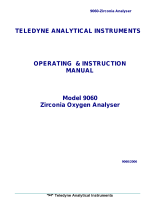Page is loading ...

1
Instruction Manual
DODGE
®
Thermocouple and Vibration Kits
These instructions must be read thoroughly before installation or operation.
WARNING: Because of the possible danger to person(s) or property from
accidents which may result from the improper use of products, it is
important that correct procedures be followed: Products must be used
in accordance with the engineering information specified in the catalog.
Proper installation, maintenance and operation procedures must be
observed. The instructions in the instruction manuals must be followed.
Inspections should be made as necessary to assure safe operation under
prevailing conditions. Proper guards and other suitable safety devices or
procedures as may be desirable or as may be specified in safety codes
should be provided, and are neither provided by Baldor Electric Company
nor are the responsibility of Baldor Electric Company. This unit and its
associated equipment must be installed, adjusted and maintained by
qualified personnel who are familiar with the construction and operation
of all equipment in the system and the potential hazards involved. When
risk to persons or property may be involved, a fail safe device must be an
integral part of the driven equipment beyond the speed reducer output
shaft.
INSTALLATION INSTRUCTIONS
Thermocouple and Transmitter
When installed properly, the output of the thermocouple and
transmitter is 4–20mA representing 0 to 250ºF. To achieve this,
the supply voltage to the transmitter must be between 8.5 and
35 volts and the maximum loop resistance should be less
than:
R
loop
< (V
supply
– 8.5 volts)/(0.02 amps)
For example, if a 24 volt supply is used then the loop resistance
should be less than 775 ohms. To protect against voltage drops,
80% of the calculated value should be used.
Accelerometer
The accelerometer requires a supply voltage between 18 and
28 volts and an excitation current of 2 to 20 milliamps. The
accelerometer produces a signal of ±5 volts representing
±50g (100mV/g). When used, the vibration transmitter requires
a supply voltage of 24 volts and produces either ±5 volts
representing ±50g or 4–20mA representing 1 inch per second
depending on the wiring conguration (Figure 2).
Preparing the Housing
1. Place the two rubberized cork gaskets on top of the bearing
housing or mounting plate supplied with the housing.
2. If a thermocouple is to be used, make sure the thermocouple
is threaded through the hole near the center of the gaskets
and that the holes for mounting the transmitter are aligned
with the threaded holes on the top of the housing or mounting
plate.
3. Fill the gap around the thermocouple with 100% silicon sealer.
Connecting Thermocouple to Temperature Transmitter
1. Place the transmitter 6 on top of the gaskets (Figure 1).
2. Using the plastic screw provided, secure the transmitter to the
housing. Be careful not to over tighten the screw.
3. Attach the thermocouple white lead to terminal 3 and red lead
to terminal 4 of the transmitter.
4. Connect the customer supplied process wire 5 to terminals
1 and 2 of the transmitter. Install a 1/2” liquid tight electrical
tting 3 on the sensor cover 1 using the hole on the side of the
sensor cover.
5. Place the sensor cover on top of the gaskets and thread the
process wire through the cover hole. Use a ex conduit to
protect the process wire.
6. Secure the sensor cover using four socket head screws and
lock washers provided. (Screws should be torqued to 65-75
in-lbs.)
Figure 1 - Mounted Thermocouple Transmitter
Figure 2 - Thermocouple Transmitter Wiring
4
53 1
6
2
4-20mA
LOOP
COPPER LEADS,
TWISTED PAIR
SENSOR
T/C
+
-
1
2
3
4
-
+
SENSOR
DC
SUPPLY
CONTROLLER
AND/OR
INDICATOR
LINE
POWER
R1
+
-

World Headquarters
P.O. Box 2400, Fort Smith, AR 72902-2400 U.S.A., Ph: (1) 479.646.4711, Fax (1) 479.648.5792, International Fax (1) 479.648.5895
Dodge Product Support
6040 Ponders Court, Greenville, SC 29615-4617 U.S.A., Ph: (1) 864.297.4800, Fax: (1) 864.281.2433
www.baldor.com
*3032-0410*
© Baldor Electric Company
MN3032 (Replaces 499041)
All Rights Reserved. Printed in USA.
4/10 TCP 15000
Connecting an Accelerometer
Note: If a thermocouple and accelerometer are to be installed
together, the thermocouple transmitter must be installed
rst.
1. Connect the customer supplied process wire 1 to the leads on
the accelerometer. Be sure to note which lead is connected to
the red lead and which is connected to the black lead.
2. Install a 1/2” liquid tight electrical tting 2 on sensor cover
using the hole on the side of the sensor cover.
3. Place sensor cover with mounted accelerometer on the
gaskets and thread the process wire through the cover hole.
Use a ex conduit 3 to protect the process wire.
4. Secure the sensor cover using four socket head screws and
lock washers provided (screws should be torqued to 65–75
in-lbs).
5. If a vibration transmitter is to be used, connect the process
wire to the rst two terminals 4 on the vibration transmitter. For
the 4–20mA output, connect a new process wire to terminals
4 and 5 of the vibration transmitter 5; for the ±5 volt output
connect the new process wire to terminals 6 and 7 of the
vibration transmitter 6. Connect a 24 volt supply to terminals 8
and 9 of the transmitter.
3
1
2
4
5
6
VIBRATION TRANSMITTER
PLC
4-20mA
INPUT CARD
24V
4-20mA
VELOCITY
±5
ACCELERATION
SIGNAL
OUT
Figure 3 - Accelerometer Connected to Vibration Transmitter
/
